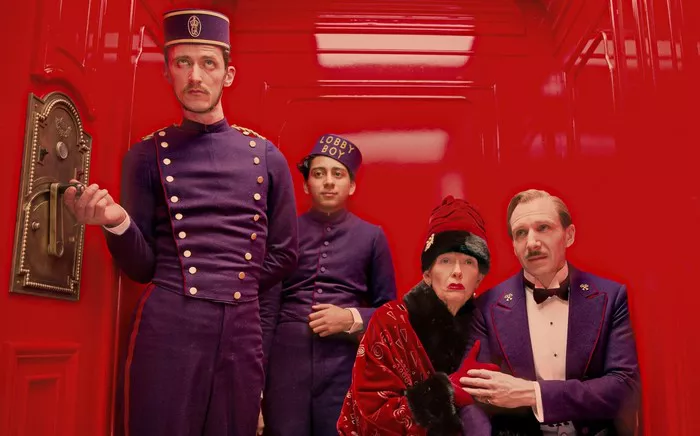In Wes Anderson’s whimsical cinematic universe, where symmetry and storytelling blend seamlessly, the visual language of fashion—particularly menswear—plays a vital, unmissable role. Whether it’s Ralph Fiennes’s fastidious Monsieur Gustave adjusting Zero’s porter hat in The Grand Budapest Hotel, or Luke Wilson’s Richie Tenenbaum pairing camel suits with a tennis headband in The Royal Tenenbaums, style is not a costume add-on in Anderson’s world—it is the character.
Menswear in Anderson’s films isn’t just wardrobe; it’s visual poetry. From Adrien Brody’s languidly styled Peter Whitman tweaking his tailored look in a cramped Indian train lavatory in The Darjeeling Limited, to Benicio del Toro stepping into Anderson’s latest film, The Phoenician Scheme, premiering this month at Cannes—fashion is a deeply embedded part of the storytelling structure. Each piece of clothing tells its own story and adds emotional depth, mood, and era-specific nostalgia.
To unpack every frame of Anderson’s carefully composed filmography would take a full course at NYU’s Tisch School of the Arts. But for now, let’s zero in on one of his most impactful—and often underappreciated—contributions: his influence on modern menswear.
Wes Anderson’s characters often wear their emotions—and their affiliations—on their sleeves, quite literally. The visual cues in costume help define who belongs and who doesn’t. Fashion becomes a shorthand for identity, allegiance, and sometimes alienation.
Film critic Robbie Collin of The Telegraph explains it well: “One of Anderson’s obsessions as a filmmaker is group identity—how odd, tight-knit communities affect the self-image of those within them.” In this context, Anderson’s costuming speaks volumes. Think of Ben Stiller and his sons clad in red tracksuits in The Royal Tenenbaums, or the coordinated flannel suits and monogrammed Louis Vuitton luggage carried by the Whitman brothers in The Darjeeling Limited. These choices aren’t just about looking good—they communicate belonging, shared trauma, and silent sorrow.
Anderson’s films rarely concern themselves with present-day reality. He draws from nostalgic palettes and vintage silhouettes, eschewing the starkness of contemporary life. His movies time-travel—often mixing aesthetics from disparate decades like 1970s Manhattan or 1980s India. This patchwork approach gives his characters a timeless, dreamlike aura, and the menswear follows suit.
Take the unforgettable costumes in The Royal Tenenbaums, with siren red tracksuits becoming both armor and uniform. Or look to the sun-faded elegance of the battered yet luxurious luggage in The Darjeeling Limited. Even in The French Dispatch, Timothée Chalamet’s minimalist suits are masterclasses in understated sophistication. And of course, there’s Monsieur Gustave, portrayed by Ralph Fiennes, whose purple uniform becomes a badge of personal pride and social distinction.
Behind these sartorial masterpieces lies a roster of fashion legends. Anderson collaborates closely with Oscar-winning costume designer Milena Canonero, whose work gives his vision tactile form. Their shared attention to detail is meticulous, nearly obsessive.
Fashion heavyweights like Marc Jacobs, during his Louis Vuitton days, and Miuccia Prada have also left their mark. In 2013, Anderson collaborated with Prada for the short film Castello Cavalcanti, starring Jason Schwartzman, and later designed the pastel-perfect Bar Luce café at Milan’s Fondazione Prada—essentially, a physical manifestation of his aesthetic.
Anderson’s fashion influence stretches well beyond film sets. Brands like Gucci and Miu Miu have drawn from his signature style, even casting actors like Adrien Brody, Willem Dafoe, and Gary Oldman—Anderson favorites—in shows that echoed his quirky yet refined sensibility.
What exactly defines a Wes Anderson menswear look? Imagine a sepia-tinged love letter to vintage fashion. His own wardrobe offers clues: tailored suits in rich, non-corporate hues like ochre, aubergine, and olive. Corduroy, velvet, and seersucker fabrics dominate. The cuts are classic but tweaked—soft-shouldered, rakish, and often paired with spread collars that whisper intellectual rebellion rather than shout conformity.
His characters wear suits not because they must, but because they choose to. There’s always an element of the story embedded in the fabric—be it sadness, longing, or camaraderie. These outfits resist the sharp, impersonal tailoring of Wall Street; instead, they celebrate the individuality of artists, dreamers, and misfits.
Texture is another crucial ingredient. From tufted corduroy to buttery suede, Anderson’s menswear revels in tactile richness. The hues lean toward warm neutrals—camel, taupe, mustard—and the overall impression is more literature professor than hedge fund manager.
Critic Robbie Collin admits that Anderson’s fashion sense has influenced his own wardrobe. “His taste levels are simply off the charts, and I’ve often pulled outfit ideas from his work,” Collin notes. He particularly admires menswear brand Drake’s, which, much like Anderson, reinterprets traditional male dress codes with subtle flair and storytelling potential.
“Anyone can break a dress code,” Collin says, “but to play revealingly inside one, like Anderson does, has a sophistication and charge to it that I can’t resist.”
In an age where fashion often relies on shock value or overt branding, Wes Anderson has changed the menswear game through quiet subversion. He hasn’t built a label or staged runway shows, but his impact is undeniable. His characters dress with intention, wit, and an undeniable romanticism. His own red carpet appearances are not for show but rather an extension of the same aesthetic values that inform his films: nostalgia, individuality, and deeply considered design.
Through his films, Wes Anderson offers a template for modern menswear that values story, texture, and color over trend. Whether it’s the symmetrical magic of The Grand Budapest Hotel or the heartfelt disarray of The Darjeeling Limited, the takeaway is clear: in Anderson’s world, clothes don’t just make the man—they reveal him.
Related Topics
- Smart, Stylish, and Comfortable: 5 Must-Have Modern Officewear Essentials for Men
- 10 Essential Wardrobe Pieces Every Man Should Own
- New DXL Store Launches in Syracuse, Delivering Perfect Fit for Big + Tall Men

